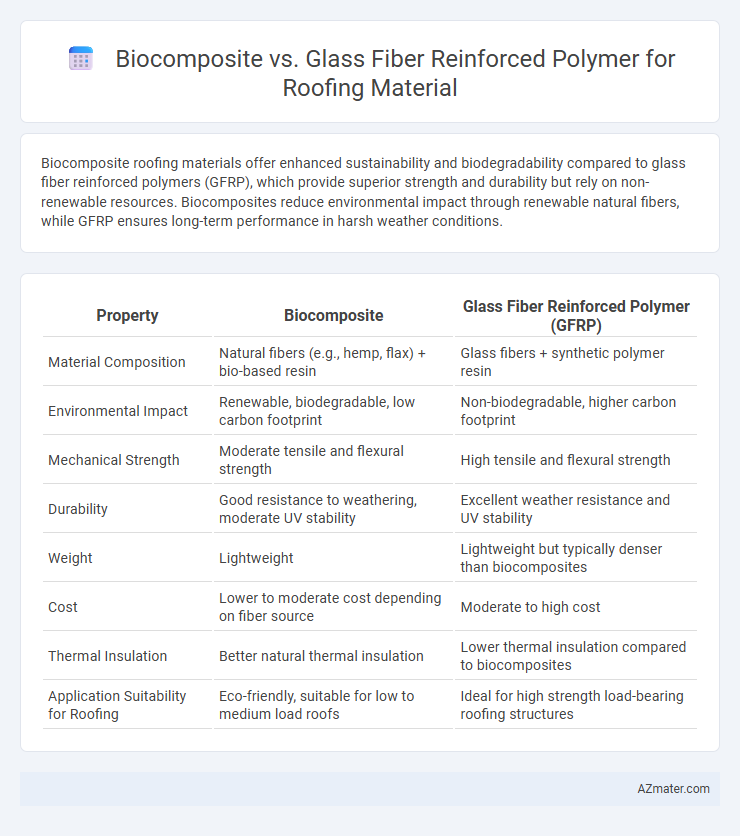Biocomposite roofing materials offer enhanced sustainability and biodegradability compared to glass fiber reinforced polymers (GFRP), which provide superior strength and durability but rely on non-renewable resources. Biocomposites reduce environmental impact through renewable natural fibers, while GFRP ensures long-term performance in harsh weather conditions.
Table of Comparison
| Property | Biocomposite | Glass Fiber Reinforced Polymer (GFRP) |
|---|---|---|
| Material Composition | Natural fibers (e.g., hemp, flax) + bio-based resin | Glass fibers + synthetic polymer resin |
| Environmental Impact | Renewable, biodegradable, low carbon footprint | Non-biodegradable, higher carbon footprint |
| Mechanical Strength | Moderate tensile and flexural strength | High tensile and flexural strength |
| Durability | Good resistance to weathering, moderate UV stability | Excellent weather resistance and UV stability |
| Weight | Lightweight | Lightweight but typically denser than biocomposites |
| Cost | Lower to moderate cost depending on fiber source | Moderate to high cost |
| Thermal Insulation | Better natural thermal insulation | Lower thermal insulation compared to biocomposites |
| Application Suitability for Roofing | Eco-friendly, suitable for low to medium load roofs | Ideal for high strength load-bearing roofing structures |
Introduction to Roofing Materials: Biocomposites and Glass Fiber Reinforced Polymers
Biocomposites consist of natural fibers combined with polymer matrices, offering sustainable roofing solutions with reduced environmental impact and improved biodegradability. Glass fiber reinforced polymers (GFRP) feature high strength-to-weight ratios, excellent durability, and resistance to weathering, making them ideal for long-lasting roofing applications. Both materials provide enhanced mechanical properties, but biocomposites prioritize ecological benefits while GFRP emphasizes structural performance.
Material Composition and Manufacturing Processes
Biocomposites for roofing materials typically consist of natural fibers like hemp or flax combined with bio-based resins, promoting sustainability and biodegradability. In contrast, glass fiber reinforced polymers (GFRP) use glass fibers embedded in a thermoset or thermoplastic resin matrix, offering superior strength and durability. Manufacturing biocomposites often involves compression molding or extrusion, whereas GFRP production relies on processes such as hand lay-up, pultrusion, or resin transfer molding to achieve high structural performance.
Mechanical Strength and Durability Comparison
Biocomposites exhibit lower tensile strength and impact resistance compared to glass fiber reinforced polymers (GFRP), which typically achieve tensile strengths of 500-800 MPa and superior rigidity. GFRP demonstrates enhanced durability with high resistance to moisture, UV radiation, and chemical degradation, making it more suitable for long-term roofing applications. While biocomposites offer environmental benefits and moderate mechanical properties (tensile strength around 50-100 MPa), their susceptibility to biodegradation limits performance under harsh weather conditions.
Thermal Insulation and Energy Efficiency
Biocomposites offer superior thermal insulation compared to glass fiber reinforced polymers (GFRP) due to their natural fiber content, which provides lower thermal conductivity and better energy efficiency in roofing applications. GFRP exhibits higher strength but tends to conduct more heat, leading to increased cooling loads and energy consumption in buildings. Selecting biocomposite roofing materials enhances overall thermal performance, reducing HVAC energy use and contributing to sustainable construction practices.
Environmental Impact and Sustainability
Biocomposites for roofing material leverage natural fibers combined with biodegradable resins, significantly reducing carbon footprint and enhancing end-of-life recyclability compared to glass fiber reinforced polymers (GFRP), which rely heavily on energy-intensive manufacturing and non-renewable raw materials. GFRP roofing products contribute to persistent environmental pollution due to microplastic generation and lengthy decomposition periods, whereas biocomposites promote circular economy principles through renewable sourcing and compostability. Sustainable roofing solutions prioritize biocomposites for their lower greenhouse gas emissions, reduced reliance on fossil fuels, and improved ecological compatibility throughout the product lifecycle.
Weather Resistance and Longevity
Biocomposites exhibit improved weather resistance due to their natural fiber composition treated with UV stabilizers and water repellents, providing moderate durability in roofing applications. Glass fiber reinforced polymers (GFRP) offer superior longevity and consistent weather resistance, excelling in UV exposure, moisture, and temperature fluctuations without significant degradation. The inherent moisture absorption in biocomposites can reduce lifespan compared to GFRP, which maintains structural integrity and dimensional stability over extended periods in harsh weather conditions.
Cost Analysis: Initial and Long-term Expenses
Biocomposites typically offer lower initial costs compared to glass fiber reinforced polymers (GFRP) due to the use of natural fibers and simpler manufacturing processes. Long-term expenses favor GFRP as they exhibit superior durability, weather resistance, and lower maintenance requirements, reducing overall lifecycle costs. Cost analysis reveals biocomposites as budget-friendly upfront options, whereas GFRP represents a cost-effective investment over extended periods through enhanced performance and longevity.
Installation Methods and Ease of Use
Biocomposite roofing materials typically offer lighter weight and greater flexibility, allowing for faster and less labor-intensive installation compared to glass fiber reinforced polymers (GFRP). GFRP requires specialized cutting tools and handling due to its rigid and abrasive nature, which can extend installation time and increase labor costs. The simpler tooling and reduced handling precautions of biocomposites contribute to their ease of use, especially in complex or curved roofing applications.
Maintenance Requirements and Life Cycle Assessment
Biocomposite roofing materials require lower maintenance due to their resistance to corrosion and moisture absorption compared to glass fiber reinforced polymers (GFRP), which often need periodic inspections and repairs for fiber degradation and resin cracking. Life cycle assessment (LCA) reveals biocomposites have a reduced environmental footprint, benefiting from renewable raw materials and biodegradability, whereas GFRP involves energy-intensive production and challenges in end-of-life recycling. Overall, biocomposites offer sustainability advantages and simplified upkeep, while GFRP provides high strength but demands more rigorous maintenance and complex disposal processes.
Future Trends and Innovations in Roofing Materials
Biocomposites for roofing materials are gaining traction due to their eco-friendly properties, incorporating natural fibers like hemp or flax with biodegradable resins that reduce carbon footprint and improve sustainability. Glass fiber reinforced polymers (GFRP) continue to evolve with enhanced durability, lightweight characteristics, and improved resistance to weathering, making them ideal for long-lasting roofing solutions. Future innovations include hybrid composites combining biocomposites and GFRP to optimize strength, environmental impact, and cost-efficiency, alongside advancements in nanomaterial additives that boost thermal insulation and fire resistance in roofing applications.

Infographic: Biocomposite vs Glass fiber reinforced polymer for Roofing material
 azmater.com
azmater.com